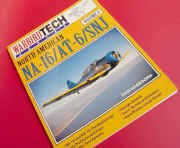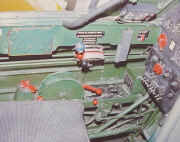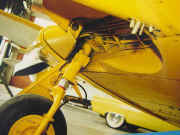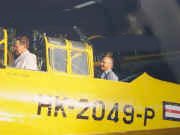Pilot Maker is definitely a well-deserved nickname for an aircraft that was a true landmark in the field of pilot training between 1935 and 1970.
This superb trainer was designed in 1934 by James H. Dutch Kindelberger, president of North American Aviation, following the military aviation standards of those days whereby a low wing and tandem cockpit aircraft was required for military pilots' training.
The Texan's structure was entirely metallic built and it had a 400 hp Wright Ciclone engine which was later substituted for a Wright R-975 E3 for the navy version, called BT-9.
The success of the NA-16, as it was initially called, was quickly recognized by many nations that bought it to train their Air Force. The final versions had a 600 hp Pratt & Whitney R-1340-49. Even today some of these beautiful specimens can be seen around the whole world, since they are still a focus of entertainment in air shows due to its versatility and acrobatic capacity.
|
About the kit
I decided to "super" detail a 1:48 kit not only because it is one of my favorite airplanes but also because I had had the chance of seeing it totally bare and taking pictures of each and every detail.
My advise for those who share this exciting hobby is to start by looking thoroughly for references when starting to build a model. These days there are many accessories in the market but they are not essential to achieve good results. I do state this as from my long experience in modeling, accumulated through more than forty years now. What we do need is motivation and patience…
I do not intend to discourage novices with this article; much on the contrary, I give them my word that they will be able to obtain a similar result. Cheer up!
|

|
|
Kit de Occidental
|

|
|
Kit de Revell
|
|
Building the model
My first choice was the T-6G Texan 1:48 model from Occidental and since I had decided to superdetail it, I included an old Revell kit to take from it only the engine, firewall and control sticks. This way, I would save a lot of time and just have to "cut out" the cowling from the other model.
|

|
I checked many pictures of the structure, engine and cockpit. Likewise, I checked the book by Dan Hagedorn, North American NA 16/T-6/SNJ of Warbird Tech Series; In Action North American T-6 by Squadron Publications; and North American T-6 by Francis Bergise of Ouest France. As accessories, I only used the Aeromaster 48398 Texan in Algiers sheet and the Eduard decal for the cockpit.
|
The first step was to build the cockpit, for which I assembled the sides with Eduard's decals and modified them according to my references on some components.
I always use a magnifying glass to achieve high quality and it is this way how I detailed the pilot and co-pilot's instrument panel. I added to the side walls those parts that the decals did not include, as well as the hydraulic and engine control lines and flaps and slats controls; the control sticks were taken from the Revell kit.
|

|
I should point out that the control and hydraulic lines were made of sprue. It is a simple process. I heat a piece of plastic -it is absolutely perfect to use the models' trees, and stretch it until I reach the desired thickness. Then, I cut out the fragments and condition them as required. Some lines have curved segments or right angles and need special care since they may break. In order to avoid this, I hold one end of the sprue with tweezers and with another pair, I mold the curves very carefully. This is done according to a previous technical scheme of each component, according to blueprints drawn as from the innermost part.
Once the cockpit was finished, I painted the fuselage inner sides with the same green as inside and cut out the area I wanted to expose by removing panels. Afterwards, I cut the engine area as from the bulkhead where the oil tank is held and glued the fuselage.
After detailed study of the documents I had, I built the oil tank in autopolimerizing acrylic of which I had made a small mold in carved wood. I placed the firewall and started the work of including all the components (electric and hydraulic lines, battery platform, heating pipes, filters and the rear part of the engine). Each of these parts had been painted before gluing them in their proper place with cyanocrylate. The next step was to glue the engine that had been previously detailed with sprue and telephone and computer wire filaments -try it since the size is perfect for our work. The engine had initially painted with Testors Burnt Iron. With dry brush technique, I later applied coats of aluminum and ochre and coffee oil, to give it the typical look of the stains made due to high temperature and burnt oil leaks.
Afterwards, I glued the wings, to which I had previously cut out the flaps since I built them with plasticard. The landing lights were made with acetate foil and a small "chaquira" -as minute bijou pearls are called here in Colombia, and were glued with transparent cement for cockpits. I detailed the landing gear bays by cutting out small plasticard bulkheads, following the documents I had adding hydraulic lines. Then, I painted everything and masked it. The next step was to glue the tail and apply the first coat of yellow paint.
Painting
Once the paint (Humbrol) was dry, I applied a thin coat of darker yellow and another one with the initial yellow on the joining areas. I also applied Testors bright transparent lacquer to the whole surface. Then I placed the decals in the correct place and after two days for drying, applied a new semi matt transparent coat. After the model was totally dry, I started to detail the joints with ochre and coffee oil. I painted the anti-reflex surface and the walkways with matt black. With a tiny Cristal Clear bubble, once dry, I made the lights. At this stage I added the landing gear which had been previously detailed with supports under the wings and the rocket rails. The last step was to weather with Spiner, put the antennas -made from sprue, and finish the tyres with a thing coat of bright gray pastel…wuuufff!!!
Conclusion
You may see the results for yourselves. I know that it cannot be clearly seen from the way I have narrated it but it would be too long to describe the whole technique in full. If you allow me, in another article, I will show you an assembly and detailing of another model, this time 1:72, with step by step pictures. With simpler things, we get better results.
|
Bibliography
Warbird Tech series North American NA-16/T-&/SNJ Dan Hagedorn
Texan In Action Squadron publications
North American T-6 Texan Francis Bergise Ouest France
|

|
|
About the Autor
I am 53. I was born in Bogotá, Colombia. I am a General and Traumatology Surgeon graduated from the National University of Colombia as a Medical Doctor and the Javierana University as specialist in General Surgery. I have worked 23 years in State institutions. For 18 years now I have been working at the Simón Bolívar Hospital, in Bogota, where I am Staff Surgeon and Head of Nutritional Support. I am Professor of Surgery at the El Bosque and La Sabana Universities.
|

|
|
Orlando with his friend, Mr. Jose Guillermo Pardo, owner of the a Texan
|
My wife, María Margarita is an ophthalmologist and we have three children. María Lucía is a writer and lives in Germany; Juan Manuel is studying Plastic Arts at the Javierana University and Alejandro is finishing high school.
I belong to the Ecuador and Colombia IPMS, "Alvaro Robledo" Bogotá Chapter. The chapter is named after my dear friend and colleague, Alvaro Robledo, with whom we shared many years of work and modeling. I started with modeling when I was 11 and I have practiced the hobby since then.
|